

Mastering For mp3. Mastered for iTunes. What Does It Mean? Mastering for a specific format - ie: mastering for mp3 or mastering for iTunes - is an idea akin to the 70's era of recording, mixing, and mastering.
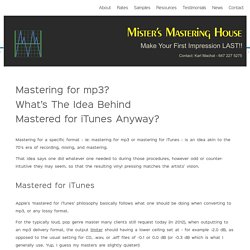
That idea says one did whatever one needed to during those procedures, however odd or counter-intuitive they may seem, so that the resulting vinyl pressing matches the artists' vision. Mastered for iTunes Apple's ‘mastered for iTunes’ philosophy basically follows what one should be doing when converting to mp3, or any lossy format. For the typically loud, pop genre master many clients still request today (in 2012), when outputting to an mp3 delivery format, the output limiter should having a lower ceiling set at - for example -2.0 dB, as opposed to the usual setting for CD, .wav, or .aiff files of -0.1 or 0.0 dB (or -0.3 dB which is what I generally use. Yup, I guess my masters are slightly quieter!) LANDR by MixGenius.
Larsen ou "noise gate", David Bowie un maître des expérimentations sonores - Sciencesetavenir.fr. IDENTITÉ.

La Spatialisation. Ci dessous vous trouverez un moteur de recherche personnalisé.
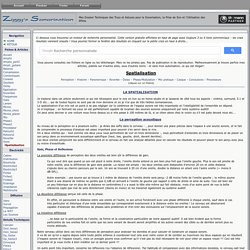
Cette version gratuite affichera en haut de page aussi toujours 3 ou 4 liens commerciaux - les vrais résultats viennent ensuite ! Vous pourrez fermer la fenêtre des résultats en cliquant sur la petite crois en haut à droite... Vous pouvez consultez ces fichiers en ligne ou les télécharger. Mais ne les piratez pas. Pas de publication ni de reproduction. Spatialisation. Split the Panning, Expand the Sound. If you’re having trouble making your mixes sound full and powerful, this article will go over one of the many methods for filling out your sound.

It’s one of the simplest music production techniques, but one of the most effective. It can be applied to Electronic Dance music, Dubstep, Hip-Hop, or any other genre. It can also be done with almost any music software, from Audacity to Reason. THE TECHNIQUE Let’s say you have a synthesizer lead for an electronic music song that needs to sound heavier. Raising the levels and moving the synth lead further in the mix isn’t quite doing what you want. First, copy and paste the track onto another separate track. Now that you have two identical tracks, it’s time to separate them.
The moment of truth happens when you take one of these tracks, either the left or the right, and move it forward in the timeline by just a few milliseconds. THE USES You can utilize the method in limitless ways. Making of "The Prodigy - Smack My Bitch Up" in Ableton by Jim Pavloff. How to Process Vocals for an Amazing Professional Sound. Persuading a problematic vocal recording to play nicely with the rest of your mix can seem like a futile task.
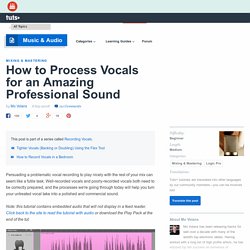
Well-recorded vocals and poorly-recorded vocals both need to be correctly prepared, and the processes we're going through today will help you turn your untreated vocal take into a polished and commercial sound. Note: this tutorial contains embedded audio that will not display in a feed reader. Click back to the site to read the tutorial with audio or download the Play Pack at the end of the tut. Before we get started, have a listen to our untreated vocal. Unprocessed Vocal The first thing you’ll probably notice about any vocal recording (good or bad) is the presence of background noise, ranging from subtle to annoying.
Before the core of the vocal signal can be tackled and processed efficiently, as much of this background noise as possible must be removed. Tips on how to mix vocals and put some effects like a professional. Vocals are the most important instrument in any audio mixing work.
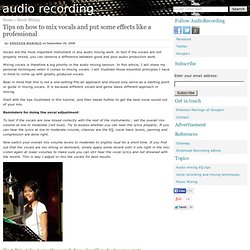
In fact if the vocals are not properly mixed, you can observe a difference between good and poor audio production work. Mixing vocals is therefore a big priority in the audio mixing session. In this article, I will share my personal techniques when it comes to mixing vocals.
Comment analyser un mix ? Et quoi de mieux que de décortiquer l’une de vos œuvres préférées afin d’en extraire les secrets pour les appliquer à vos propres productions ?
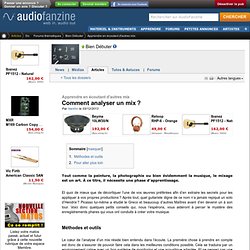
Après tout, quel guitariste digne de ce nom n’a jamais repiqué un solo d’Hendrix ? Picasso lui-même a étudié le Greco et beaucoup d’autres Maîtres avant d’en devenir un à son tour. Voici donc quelques petits conseils qui, nous l’espérons, vous aideront à percer le mystère des enregistrements phares qui vous ont conduits à créer votre musique. Méthodes et outils Le cœur de l’analyse d’un mix réside bien entendu dans l’écoute. Ensuite, sachez que votre écoute se fera à plusieurs niveaux. Recording.
La méthodologie pour le mastering maison. Méthodologie Les outils dont vous aurez besoin lors d'une session de mastering sont plus ou moins les mêmes que ceux utilisés pour le mixage.
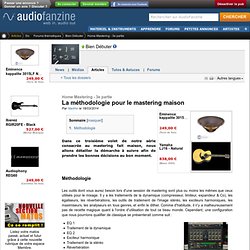
Il y a les traitements de la dynamique (compresseur, limiteur, expandeur & Co), les égaliseurs, les réverbérations, les outils de traitement de l'image stéréo, les exciteurs harmoniques, les maximiseurs, les analyseurs en tous genres, et enfin le dither. Compression. 16 Bit vs. 24 Bit Audio. This article is going to be kept as simple as possible.

It's just designed to get the new person up to speed on the issues and provide a strong sense of perspective on what really matters. We are going to talk about bit depth and sample rates, how these translate into storage requirements, and then talk about the subjective differences between the two methods of recording your music. In short, what is the relation of 24 bit recordings to the "sound quality" we all want. When I first ventured into digital audio, it was a much simpler world. Products that recorded and generated digital audio were all 16 bit. INFOS MASTERING - Kilohertz Studio / NeoMastering. Mixage, Mastering. How to ? prepare for mastering. Secrets Of The Mix Engineers. Finding real-world advice from established creative mixing engineers and record producers is not at all easy, since most tend to be highly protective about their approaches and the tricks of their craft, but this popular series written by long-time SOS author and musician Paul Tingen gets them to open up and explain the technical and artistic detail of the mixing sessions of a well-known chart hit they worked on.

Open Access unlocked Peter Cobbin & Kirsty Whalley Inside Track | Secrets Of The Mix Engineers: Underpinning the biggest spectacle of 2012 was probably the largest multitrack recording ever made. Professional, low cost, online mastering service. Secrets de studio. How to Make Mixes Sound Big. Tech By Soundista | How to Make Mixes Sound Big The level of perceived loudness in your music can make it more exciting, more engaging and more driving.
Loudness is not quite as simple as it may seem on the surface, however, and there are some points that generally need clarification. Electronic Music Production Tips and Tricks. Making of "The Prodigy - Smack My Bitch Up" in Ableton by Jim Pavloff. Mixage + Mastering ONLINE. Mixage / Mastering. HOW TO MASTER A SONG STEP BY STEP. Mixage. Twelve Common Mixing Mistakes. As a mastering engineer, I hear a lot of mixes from other studios. Some are great, some are not. But what is striking to me is that the mixes that need help usually suffer from many of the same problems. The good news is that these shortcomings can all be avoided or corrected by using a few simple techniques. In this article, I will describe 12 common problems with wayward mixes and discuss how to solve them. If your mixes are routinely restrained by a lack of punch, clarity, and detail; if your productions are held hostage by unruly dynamics and spectral imbalances; or if your results don't sound as wide and deep as the mondo tracks created by your competition, read on for some liberating pointers.
Boomy or Thin-Sounding Mix The most common problem I hear with mixes is uneven levels throughout the range of bass frequencies. FIG. 1: The Frontier Design Group TranzPort wireless DAW controller is excellent for working from an alternate position in the control room. Edgy, Fatiguing Sound. Formation mastering. Formation mixage. Produire un gros son de batterie rock. Au niveau de la production et du mixage comme à celui de l'enregistrement, il y a deux manières d'aborder la batterie qui sont parfaitement complémentaires.
D’un côté, vous pouvez la considérer dans sa globalité, comme un instrument, de l’autre vous pouvez la considérer comme un ensemble d'instruments (caisse claire, grosse caisse, toms, cymbales, etc.). Maitriser les Basses Fréquences dans le Mixage. Un problème qui se pose souvent lorsqu’on se lance dans le mixage d’un titre, c’est comment marier la grosse caisse et la basse, et bien maitriser les basses fréquences. En mixage, il est difficile de donner des pré-réglages et des « règles » toutes faites à appliquer car chaque style musical est bien différent, et les corrections à appliquer lors du mixage dépendent complètement de la prise de son s’il s’agit d’instruments acoustiques, ou de la qualité des samples et des banques de son, s’il s’agit de musique électronique.